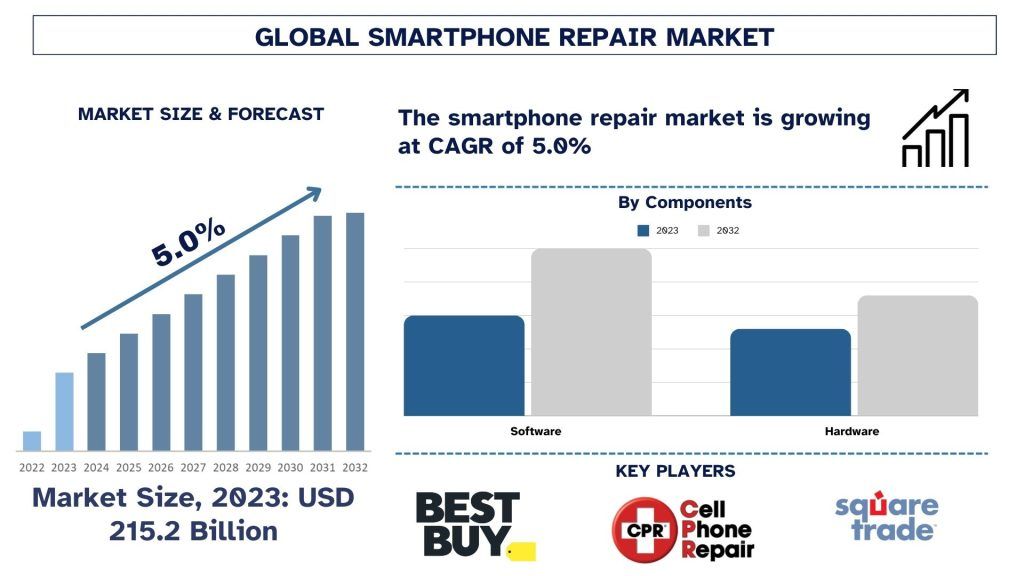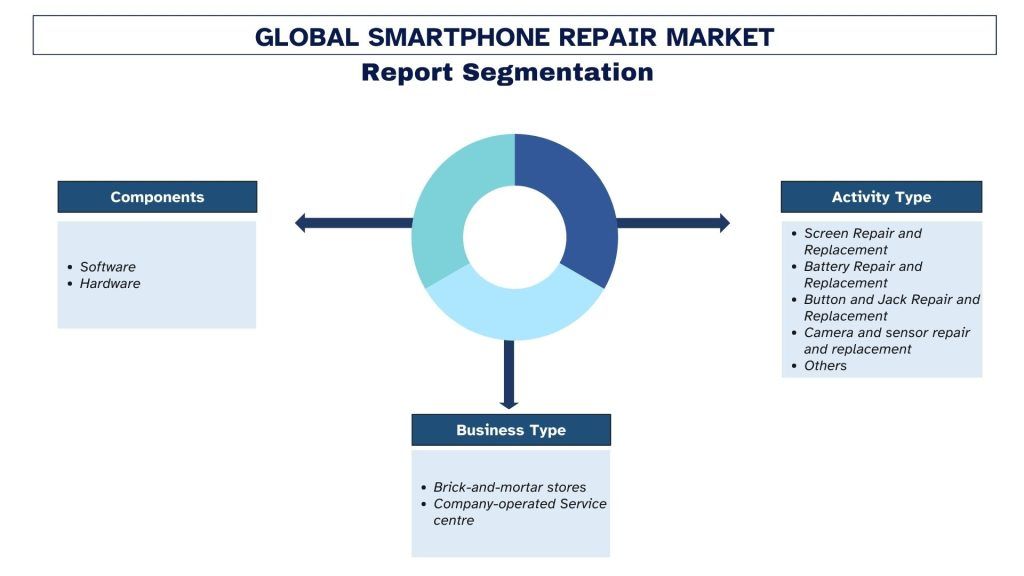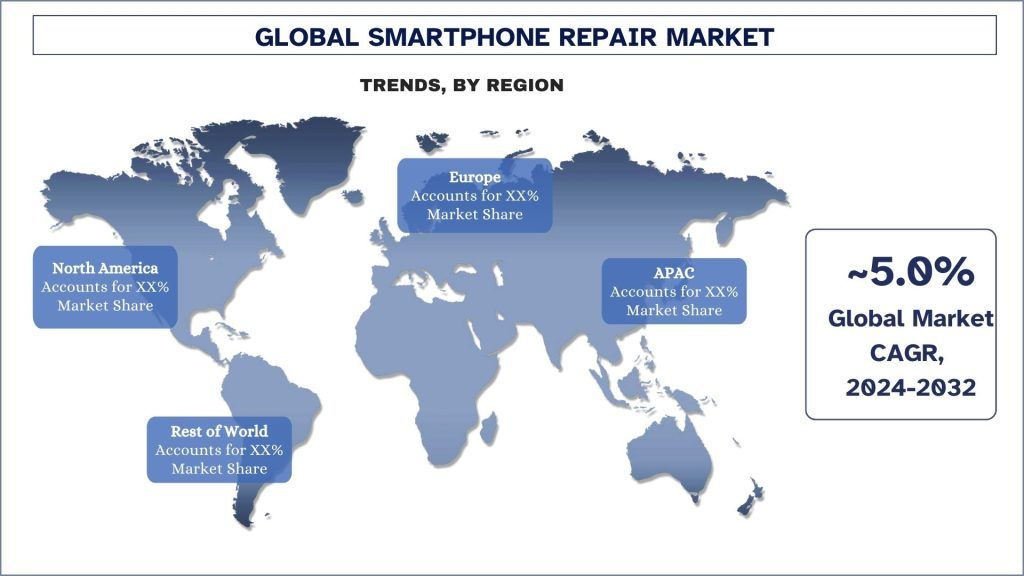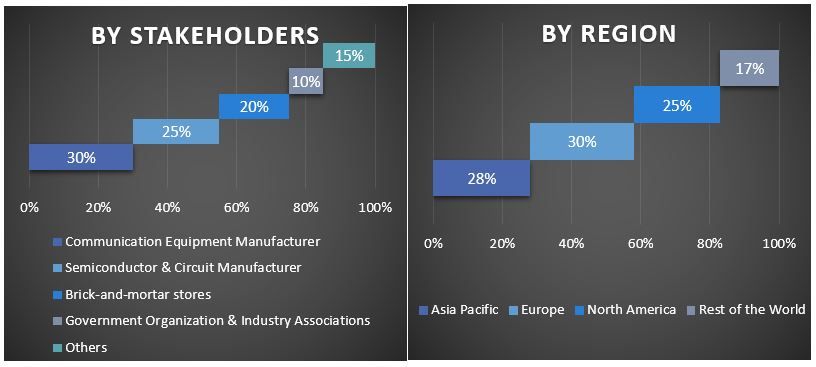- Home
- About Us
- Industry
- Services
- Reading
- Contact Us
Smartphone Repair Market: Current Analysis and Forecast (2024-2032)
Emphasis on Component (Software, Hardware); Activity Type (Screen Repair and Replacement, Battery Repair and Replacement, Button and Jack Repair and Replacement, Camera & sensor Repair and Replacement, Others (Software related); Business Type (Brick-and-mortar stores, Company operated Service center) and Region & Country.

Smartphone Repair Market Size & Forecast
The Smartphone Repair market was valued at approximately USD 215.2 Billion in 2023 and is expected to grow at a robust CAGR of around 5% during the forecast period (2024-2032) owing to the increasing smartphone adoption, rising repair affordability compared to replacements, and growing environmental sustainability awareness.
Smartphone Repair Market Analysis
Smartphones have changed the world in a remarkably brief time frame. Currently, nearly half of the world’s population uses a smartphone and annual spending on new smartphone hardware exceeds 370 billion US dollars. Owing to the growing dependence on smartphones as well as the availability of affordable smartphones, the average global smartphone replacement cycle has reached 21 months. Customers from the emerging market are more aggressively replacing their smartphones, compared to customers in the developed economy. The growth of Chinese brands, which offer higher specification devices at affordable prices, has generated a faster upgrade cycle. In addition, the rise of used and refurbished smartphones is also catalyzing this trend.
Smartphone Repair Market Trends
This section discusses the key market trends influencing the Smartphone Repair segments as identified by our research experts.
Software Component Transforming Industry
The software segment is a critical part of the smartphone repair market because it provides repair shops with the tools and resources needed to quickly and accurately diagnose and fix software-related issues on smartphones. This can include fixing bugs, updating apps, and troubleshooting software glitches. Due to the increasing demand for high-performance mobile phones, the demand for the software segment also increases in the smartphone repair market.

Asia Pacific is expected to Dominate the Market
The Asia Pacific region has a large population of smartphone users, with millions of devices in circulation. This extensive user base created a substantial demand for repair services as the devices inevitably experienced issues or damage over time. As a result, the market for smartphone repair is witnessing growth in the region. Further, the region is known for being a competitive market for smartphone manufacturers. Consumers had access to a wide range of brands and models, leading to a diverse pool of devices needing repair services.

Smartphone Repair Industry Overview
Smartphone Repair is competitive, with several global and international market players. The key players are adopting different growth strategies to enhance their market presence, such as partnerships, agreements, collaborations, new product launches, geographical expansions, and mergers and acquisitions. Some of the major players operating in the market are Apple inc., Best Buy Co. Inc., Cell Phone Repair Franchise Systems Inc., SquareTrade, Inc, LG Electronics, SAMSUNG, HTC Corporation, uBreakiFix, Staymobile, Motorola Mobility LLC. Several M&As along with partnerships have been undertaken by these players to facilitate customers with hi-tech and innovative products/technologies.
Smartphone Repair Market Report Coverage
Report Attribute | Details |
Base year | 2023 |
Forecast period | 2024-2032 |
Growth momentum | Accelerate at a CAGR of 5 % |
Market size 2023 | ~USD 215.2 billion |
Regional analysis | North America, Europe, Asia-Pacific, Rest of the World |
Major contributing region | The Asia Pacific is expected to grow at the highest CAGR during the forecasted period. |
Key countries covered | U.S., Canada, Germany, France, UK, Spain, Italy, China, Japan, India. |
Apple inc., Best Buy Co. Inc., Cell Phone Repair Franchise Systems Inc., SquareTrade, Inc, LG Electronics, SAMSUNG, HTC Corporation, uBreakiFix, Staymobile, Motorola Mobility LLC | |
Report Scope | Market Trends, Drivers, and Restraints; Revenue Estimation and Forecast; Segmentation Analysis; Demand and Supply Side Analysis; Competitive Landscape; Company Profiling |
Segments Covered | By Component, Activity Type, Business Type, By Region/Country |
Smartphone Repair Market News
- For instance, in 2024, Oppo announced new customer service initiatives under its Service Centre 3.0 across India. The company has announced that it has expanded its service centres to 25,000 PIN codes with the facility of pick-up and drop services.
- For instance, in 2024, Google responded to reports of screen problems on the Pixel 8 by offering an extended repair program for affected devices. If your Pixel 8 is experiencing vertical lines or flickering displays, you may be eligible for a free fix up to three years after your purchase.
Reasons to buy this report:
- The study includes market sizing and forecasting analysis validated by authenticated key industry experts.
- The report presents a quick review of overall industry performance at one glance.
- The report covers an in-depth analysis of prominent industry peers with a primary focus on key business financials, product portfolios, expansion strategies, and recent developments.
- Detailed examination of drivers, restraints, key trends, and opportunities prevailing in the industry.
- The study comprehensively covers the market across different segments.
- Deep dive regional level analysis of the industry.
Customization Options:
The global Smartphone Repair can further be customized as per the requirement or any other market segment. Besides this, UMI understands that you may have your own business needs; hence, feel free to connect with us to get a report that completely suits your requirements.
Table of Content
Research Methodology for the Smartphone Repair Market Analysis (2024-2032)
Analyzing the historical market, estimating the current market, and forecasting the future market of the global Smartphone Repair market were the three major steps undertaken to create and analyze the adoption of Smartphone Repair in major regions globally. Exhaustive secondary research was conducted to collect the historical market numbers and estimate the current market size. Secondly, numerous findings and assumptions were taken into consideration to validate these insights. Moreover, exhaustive primary interviews were also conducted, with industry experts across the value chain of the global Smartphone Repair market. Post assumption and validation of market numbers through primary interviews, we employed a top-down/bottom-up approach to forecasting the complete market size. Thereafter, market breakdown and data triangulation methods were adopted to estimate and analyze the market size of segments and sub-segments of the industry. Detailed methodology is explained below:
Analysis of Historical Market Size
Step 1: In-Depth Study of Secondary Sources:
A detailed secondary study was conducted to obtain the historical market size of the Smartphone Repair market through company internal sources such as annual reports & financial statements, performance presentations, press releases, etc., and external sources including journals, news & articles, government publications, competitor publications, sector reports, third-party database, and other credible publications.
Step 2: Market Segmentation:
After obtaining the historical market size of the Smartphone Repair, we conducted a detailed secondary analysis to gather historical market insights and share for different segments & sub-segments for major regions. Major segments are included in the report, such as component, activity type, business type, and region. Further country-level analyses were conducted to evaluate the overall adoption of testing models in that region.
Step 3: Factor Analysis:
After acquiring the historical market size of different segments and sub-segments, we conducted a detailed factor analysis to estimate the current market size of the Smartphone Repair market. Further, we conducted factor analysis using dependent and independent variables such as component, activity type, business type, and Smartphone Repair regions. A thorough analysis was conducted of demand and supply-side scenarios considering top partnerships, mergers and acquisitions, business expansion, and product launches in the Smartphone Repair market sector across the globe.
Current Market Size Estimate & Forecast
Current Market Sizing: Based on actionable insights from the above three steps, we arrived at the current market size, key players in the global Smartphone Repair market, and market shares of the segments. All the required percentage shares split and market breakdowns were determined using the above-mentioned secondary approach and were verified through primary interviews.
Estimation & Forecasting: For market estimation and forecast, weights were assigned to different factors including drivers & trends, restraints, and opportunities available for the stakeholders. After analyzing these factors, relevant forecasting techniques i.e., the top-down/bottom-up approach were applied to arrive at the market forecast for 2032 for different segments and sub-segments across the major markets globally. The research methodology adopted to estimate the market size encompasses:
- The industry’s market size, in terms of revenue (USD) and the adoption rate of the Smartphone Repair across the major markets domestically
- All percentage shares, splits, and breakdowns of market segments and sub-segments
- Key players in the global Smartphone Repair in terms of products offered. Also, the growth strategies adopted by these players to compete in the fast-growing market
Market Size and Share Validation
Primary Research: In-depth interviews were conducted with the Key Opinion Leaders (KOLs), including Top Level Executives (CXO/VPs, Sales Head, Marketing Head, Operational Head, Regional Head, Country Head, etc.) across major regions. Primary research findings were then summarized, and statistical analysis was performed to prove the stated hypothesis. Inputs from primary research were consolidated with secondary findings, hence turning information into actionable insights.
Split of Primary Participants in Different Regions

Market Engineering
The data triangulation technique was employed to complete the overall market estimation and to arrive at precise statistical numbers for each segment and sub-segment of the global Smartphone Repair. Data was split into several segments and sub-segments after studying various parameters and trends in the component, activity type, business type, and regions of the global Smartphone Repair market.
The main objective of the Global Smartphone Repair Market Study
The current & future market trends of the global Smartphone Repair were pinpointed in the study. Investors can gain strategic insights to base their discretion for investments on the qualitative and quantitative analysis performed in the study. Current and future market trends determined the overall attractiveness of the market at a regional level, providing a platform for the industrial participant to exploit the untapped market to benefit from a first-mover advantage. Other quantitative goals of the studies include:
- Analyze the current and forecast market size of the Smartphone Repair market in terms of value (USD). Also, analyze the current and forecast market size of different segments and sub-segments.
- Segments in the study include areas of component, activity type, business type, and regions.
- Define and analyze the regulatory framework for the Smartphone Repair
- Analyze the value chain involved with the presence of various intermediaries, along with analyzing customer and competitor behaviors of the industry.
- Analyze the current and forecast market size of the Smartphone Repair market for the major regions.
- Major countries of regions studied in the report include Asia Pacific, Europe, North America, and the Rest of the World
- Company profiles of the Smartphone Repair market and the growth strategies adopted by the market players to sustain in the fast-growing market.
- Deep dive regional level analysis of the industry
Frequently Asked Questions FAQs
Q1: What is the global Smartphone Repair's current size and growth potential?
Q2: What are the driving factors for the growth of the global Smartphone Repair?
Q3: Which segment has the largest share of the global Smartphone Repair by component?
Q4: What are the emerging technologies and trends in the global Smartphone Repair?
Q5: Which region will dominate the global Smartphone Repair?
Related Reports
Customers who bought this item also bought









